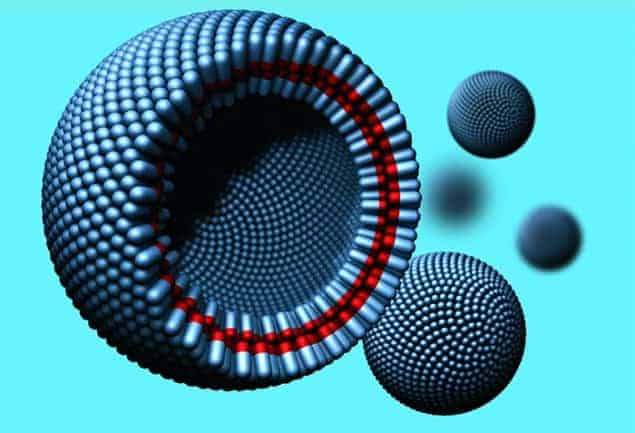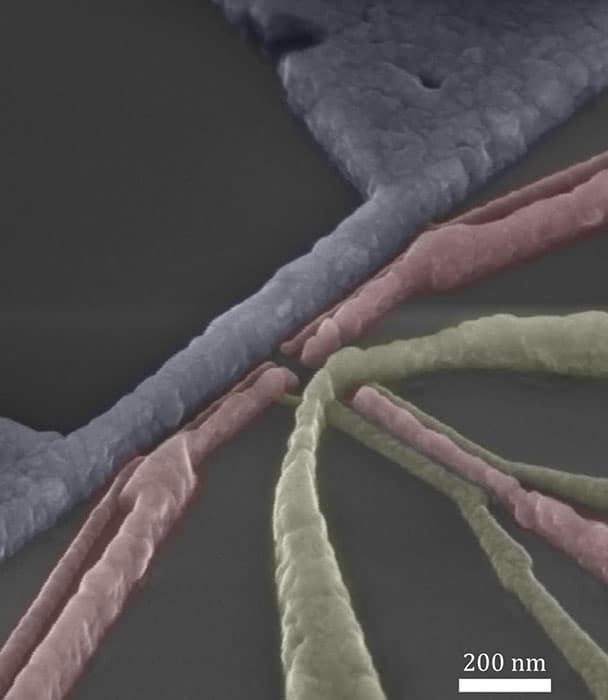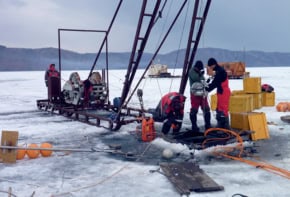Flash Physics is our daily pick of the latest need-to-know developments from the global physics community selected by Physics World‘s team of editors and reporters

Artificial cell-like spheres made from proteins
Artificial spheres that resemble living cells have been made from proteins by physicists at the University of Saarland in Germany. The structures could someday be used to encapsulate and transport drugs to targeted locations in the body and were created by Karin Jacobs and colleagues. The spheres are made from hydrophobin molecules, which are naturally occurring stringy proteins that are used by fungi to create waterproof coatings. After noticing that the molecules tend to form clumps when in solution, the team used criss-crossing streams of oil and water to push the clumps together to form tiny hollow spheres with walls made from a double-layer of the proteins (see figure). The team was able to “inflate” the spheres by boosting the water pressure inside. The researchers were also able to create ion channels in the walls of the spheres, which could be used to simulate how living cells exchange ions with their surroundings. The physicists are hopeful that they could even make artificial vesicles using their technique, which is described in Advanced Materials.
Shape-shifting seen in zirconium nuclei
One fascinating aspect of some atomic nuclei is that they adopt non-spherical shapes in their lowest energy states. This phenomenon is known as shape coexistence and has proven very difficult to describe theoretically. Now, Tomoaki Togashi and colleagues at the University of Tokyo have performed computer simulations of zirconium nuclei containing 50–70 neutrons. These suggest that the nucleus is a sphere when it has 52–56 neutrons and then undergoes a transition to a deformed shape for a higher number of neutrons – something that is backed up by experimental evidence. The simulations also suggest that the transition is a quantum phase transition, say the physicist writing in Physical Review Letters. The calculations also predict that zirconium nuclei in the transition region around 56 neutrons can coexist in spherical and deformed shapes that differ very slightly in terms of energy. To study this further, Togashi and colleagues joined forces with an international team working on the S-DALINAC accelerator in Darmstadt, Germany. There, they found evidence for this shape coexistence in zircon-96, which has 56 neutrons. The experimental work is also reported in Physical Review Letters.
Silicon-qubit lifetime boosted by factor of 10

The lifetime of a quantum bit (qubit) of information stored in the spin of an electron in silicon has been increased by a factor of 10 by Andrea Morello and colleagues at the University of New South Wales in Australia. Silicon could be useful for creating quantum computers because electronic devices based on the semiconductor can be made with great precision. Quantum information can be stored in the spins of electrons in silicon, but several challenges must first be overcome before practical quantum devices can be made. One problem is that the spins interact with their environment and lose their quantum information in a process called decoherence. In this latest work, Morello’s team worked with the spins of individual phosphorous atoms that were implanted in silicon. Previous studies have shown that these spins can store quantum information for about 200 μs in the presence of a magnetic field. Writing in Nature Nanotechnology, the team describes how it has used an applied microwave signal to boost the lifetime of the spin qubits to 2.4 ms. The microwaves cause the spins to oscillate at a specific frequency, making them much more robust to interference. An added benefit of the new spin qubit is that it can be controlled using microwave signals – unlike the team’s previous spin qubits.
- You can find all our daily Flash Physics posts in the website’s news section, as well as on Twitter and Facebook using #FlashPhysics. Tune in to physicsworld.com later today to read today’s extensive news story on the entropy of consciousness.



